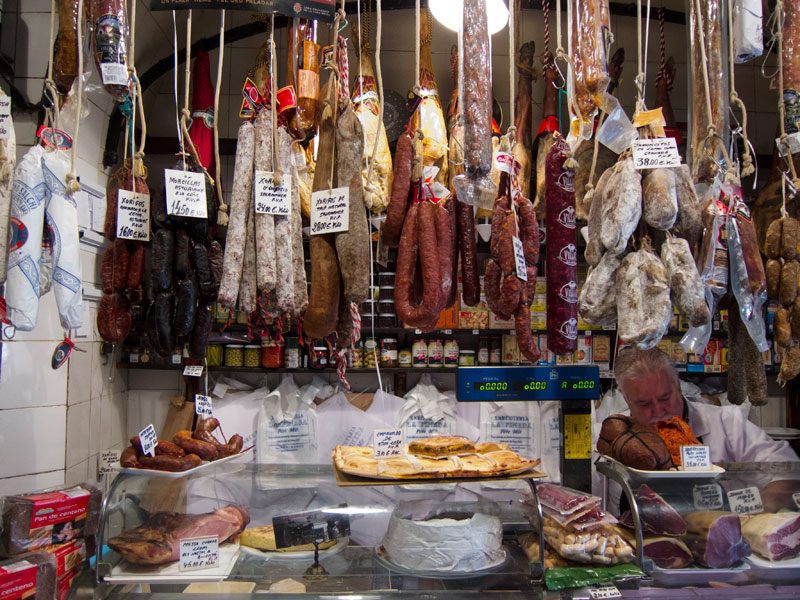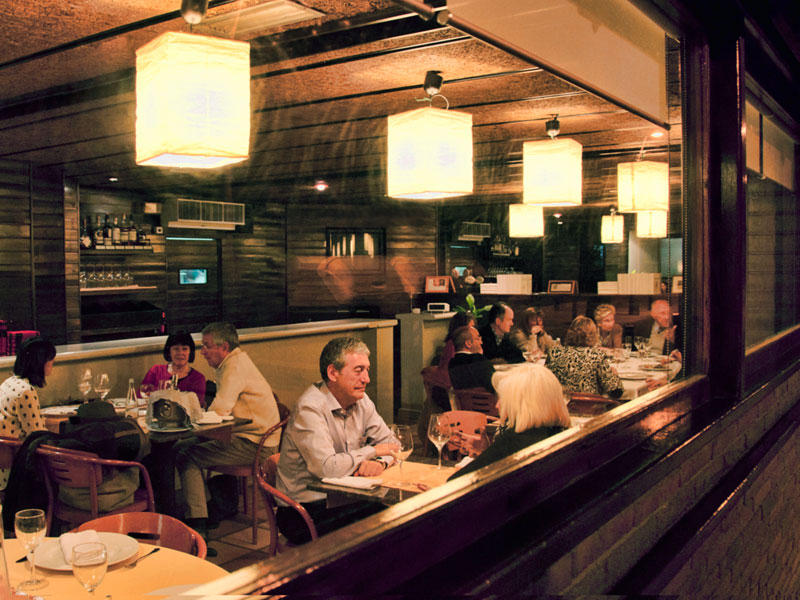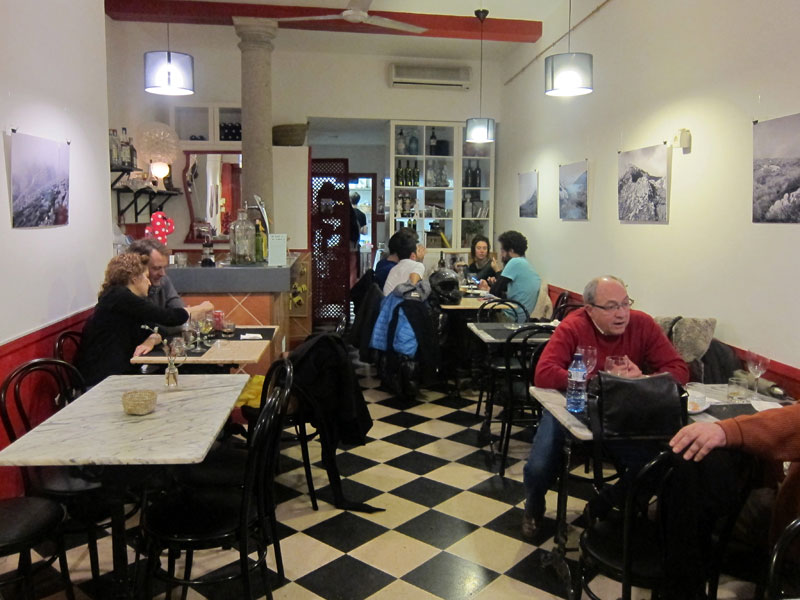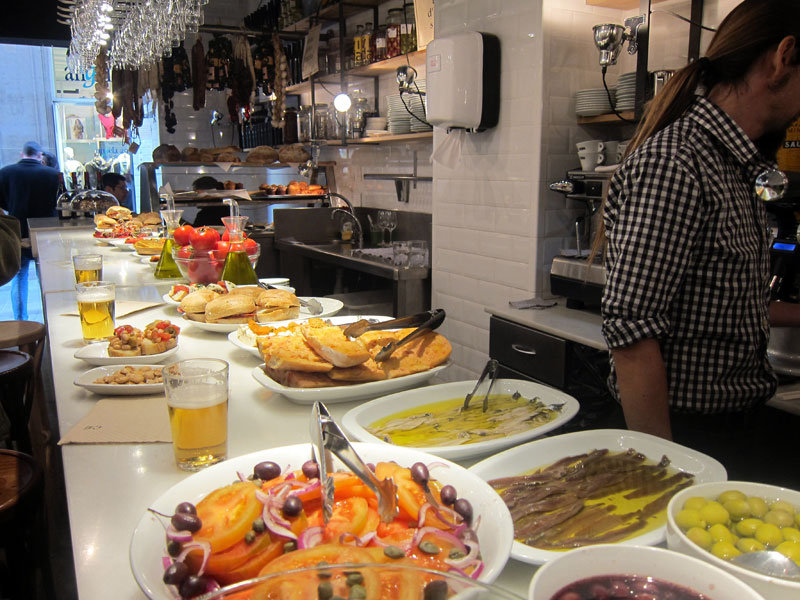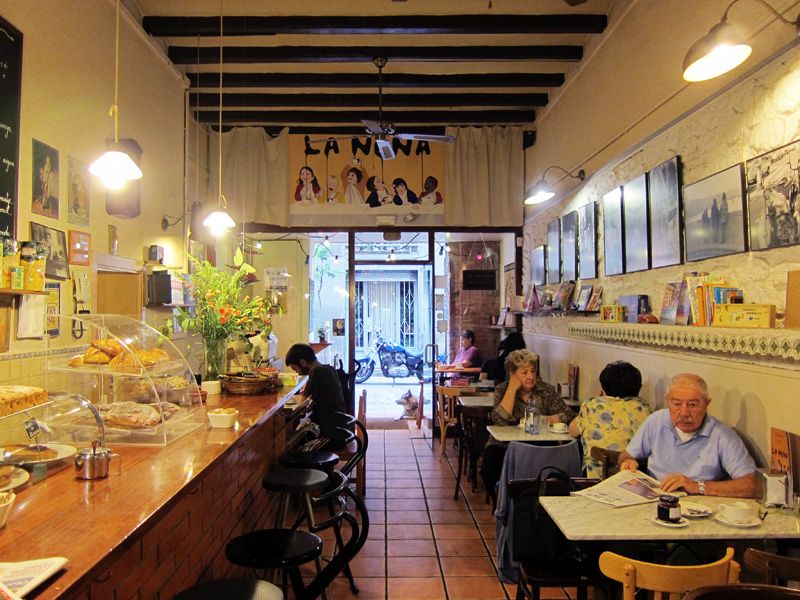We can't find the internet
Attempting to reconnect
Something went wrong!
Hang in there while we get back on track
Search results for "Johanna Bailey"
Barcelona
Bar Bodega Quimet: Same As It Ever Was
De toda la vida is a Spanish expression that basically means “It’s been around forever,” and it’s a sure thing that the locals in Barcelona’s Gràcia neighborhood will utter those words if you ask them about Bodega Quimet. Opened in the 1950s by the Quimet family, the bodega (not to be confused with Quimet i Quimet, a popular Barcelona tapas bar) was passed down from father to son until 2010, when the younger (but nonetheless old) Quimet retired and brothers Carlos and David Montero bought the venue. David Montero had always worked as a cook and dreamed of owning his own place. However, after buying Quimet, instead of doing the renovations so typical of Barcelona bars that change hands (such as modernizing the furnishings or installing a huge flat-screen TV for showing fútbol matches), the Montero brothers made the somewhat unusual decision to keep everything, from the low prices to the décor, pretty much the same as it always had been.
Read moreBarcelona
Sagàs: Hands-On Cuisine
It all started with a seriously delicious hamburger in New York City. Rumor has it that it was this burger that first gave acclaimed Catalan chef Oriol Rovira the idea of opening Sagàs Pagesos y Cuiners (“Farmers and Cooks”) in the Born district of Barcelona. Specializing in high-end sandwiches, the restaurant embraces the farm-to-table philosophy, with a menu that is both distinctively Catalan and international in scope. Rovira, who also runs Els Casals, a Michelin-starred restaurant in the tiny village of Sagàs near the edge of the Pyrenees, opened his sandwich spot in May 2011. As at Els Casals, nearly all of the food at the Barcelona venue comes straight from the chef’s village farm. But why sandwiches?
Read moreBarcelona
Casa Trampa: The Great Escape
Most people who visit Barcelona are sure to spend at least some time at one of the city’s beaches. Yet few are aware that when seeking respite from the bustling urban streets, heading up into the forested hills above the city can be just as pleasant. Vallvidrera, a village at the entrance to Collserola National Park that offers gorgeous views of the surrounding forests and the city below, is just the place for such an excursion. Starting in the early 19th century and up until the 1980s, Vallvidrera served as a vacation destination for wealthy Barcelonans who wanted to escape the summertime heat of the city. The abundance of mansions here, many built in the Modernist style, is a testament to this bygone era. Nowadays, although Vallvidrera is a year-round community that is technically part of Barcelona proper, it’s still a destination for local urbanites and their families wanting to get out of the city and relax, particularly on weekends.
Read moreBarcelona
La Pineda: The Sausage Club
It’s almost impossible to pass through Barcelona without setting foot in the Barrio Gótico, a warren of narrow, winding streets and medieval buildings that is the historic center of the old city. It’s also the epicenter of Barcelona’s tourist trade, which means that amongst all the Zara window displays, souvenir shops and tapas joints of questionable quality, it can be difficult to catch a glimpse of what the neighborhood once was. One lucky day, however, as we made our way through this touristic mishmash, we stumbled upon La Pineda, a true gem of old barrio authenticity.
Read moreBarcelona
Ask CB: Local Cafés in Barcelona?
Dear Culinary Backstreets, Where can I go in Barcelona when I'm tired of sightseeing and I just want to sit down and relax with a cup of coffee? Visiting museums and landmarks can be a lot of fun when you're a tourist but sometimes you can learn more about the life of a city by sitting in a chair in a café than you can by reading any guidebook. In Barcelona, there's no shortage of cafés but like anywhere else, it can sometimes be a bit tricky to find one that has just the right ambiance.
Read moreBarcelona
Barcelona’s Top Street Foods
Editor’s note: This feature from Barcelona is the third installment in our series this week devoted to the top street foods in each of the Culinary Backstreets cities. In Barcelona, a great deal of eating is done in the streets. Sidewalk cafés line the plazas and paseos, often to the point that it’s difficult to tell which tables belong to which establishment.
Read moreBarcelona
Andorra: Vintage Revival
As a child, Manel Palou spent hours playing in the kitchen of Andorra, his parents’ restaurant in Barcelona’s Barrio El Born. Later, as a teenager, he helped out behind the counter while his brother Miki cooked in the kitchen. Originally bought by his grandfather in 1952, the small restaurant had been around for as long as anyone could remember; even the old-timers in the neighborhood can’t remember where the name comes from or who the previous owners were. Then in 2004, Manel’s parents decided to sell Andorra and retire. Within six years, the restaurant went from being a neighborhood favorite to a mediocre Italian joint with few clients and little charm.
Read moreBarcelona
Pa de Sant Jordi: Barcelona's Bread of Love
In Barcelona, Valentine’s Day is no big deal. On the other hand, on April 23, you had better remember to buy a flower for your sweetheart. La Diada de Sant Jordi is one of the most important holidays in Catalonia, honoring its patron Saint George. The Catalan tradition – inspired by the legend of Saint George’s chivalrous slaying of a dragon to save a princess – is for men to buy roses for women and, in return, for women to buy books for men.
Read moreBarcelona
Ask CB: Eating Early in Barcelona?
Dear Culinary Backstreets, I hear that Spaniards take their dinner very late. Are there any good restaurants in Barcelona that start serving dinner before 9 p.m.? Indeed, Spaniards are notorious for eating late. Even when dining at home, the typical Spanish family doesn’t eat their dinner until around 9 or 10 p.m. – or sometimes even later! The main reason for this is that for most people in Spain, lunch – which usually consists of at least two courses and is eaten at some point between 1:30 and 4 p.m. – is the most substantial meal of the day. It makes sense, then, that nobody has much of an appetite again until late in the evening.
Read moreBarcelona
Restaurant Roma: Comfort Food, Catalan Style
At first glance, Restaurant Roma doesn’t appear to be anything out of the ordinary. The nondescript brown tiles covering the floors, the dark wood bar, the vaguely Mediterranean-inspired wall décor and the rectangular paper Ikea lamps are similar to those at hundreds of other midrange restaurants throughout Barcelona. Situated on a quiet street in residential Sant Gervasi, Roma isn’t somewhere you’d be likely to come across accidentally, nor is it the kind of place you’d happen to hear about, unless you (or your aunt, or coworker or a friend of a friend) lived nearby. And that would be a shame because the food at Roma is good – ridiculously delicious, in fact.
Read moreBarcelona
Na Mindona: Island Style
When Xisca Ferragut left Mallorca (the largest of the Balearic Islands, located in the Mediterranean Sea off the eastern coast of Spain) and moved to Barcelona, she had no intention of opening a restaurant. Having lost her job back in Mallorca, she had decided to study sign language and become an interpreter. Then her boyfriend, Dionis Ballester, showed up and as the two struggled to find work, they noticed something: there were literally NO Mallorcan restaurants in Barcelona.
Read moreBarcelona
Ask CB: Tortilla Española in Barcelona?
Dear Culinary Backstreets, In just about every restaurant or bar I’ve been to in Barcelona, I’ve seen a dish called “tortilla.” What exactly is a tortilla and can you recommend any places where they are done especially well? Although it would seem that much of the world imagines the inhabitants of Spain subsisting largely on paella, the truth of the matter is that it is the tortilla española, also known as tortilla de patatas (truita de patata in Catalan), that really holds the place of honor in the hearts and stomachs of Spaniards. Often translated into English on menus as “potato omelet,” this hearty round cake of potatoes, eggs, olive oil and salt has nothing to do with the traditional French omelet, nor does it have anything in common with a Mexican tortilla. At its most basic, the Spanish tortilla is made by frying up a thick mass of sliced potatoes and eggs in olive oil and then slicing it into savory wedges.
Read moreBarcelona
Bagauda: Northern Comfort
Editor's Note: Sadly, this spot is now closed. Everyone knows that Germany and France can both make a mean loaf of bread. But what about Spain? When was the last time you heard someone say something like, “What this meal really needs is some delicious Spanish bread!” You’ve never heard anyone say that and the reason is that the bread in Spain is, with few exceptions, decidedly mediocre, with even the smallest bakeries producing the majority of their “fresh-baked” product using partially baked or frozen dough made in factories using industrial yeasts and preservatives.
Read moreBarcelona
Best Bites of 2012: Barcelona
Editor’s note: This is the penultimate installment of “Best Bites of 2012,” a roundup of our top culinary experiences over the last year. Stay tuned for our final “Best Bites” dispatch, from Istanbul, tomorrow. Restaurant Roma We hadn’t planned on bringing in La Nochevieja at Restaurant Roma, but it was nearby and we didn’t feel up for public-transport adventures on New Year’s Eve. Situated on a quiet street in the upscale but untouristy Barcelona neighborhood of Sant Gervasi, Roma is thoroughly nondescript – a neighborhood joint frequented by neighborhood people of a certain age. The wood-paneled walls, racks of Maxim magazines and TV mounted in the corner kept our expectations pretty low.
Read moreBarcelona
La Nena: Gràcia’s Sweet Temptation
The large banner in La Nena chocolatería proclaiming “No Hay Alcohol” (strung up between a rocking horse and a wooden toy kitchen) makes it fairly clear that this is not a place for sophisticated conversation and cocktails. That doesn’t mean that La Nena (which means “The Girl” in Catalan) doesn’t cater to any other vices. Indeed, its delicious homemade cakes, pastries, hot chocolates and savory snacks tempt the residents of Barcelona’s Gràcia neighborhood on a daily basis.
Read more


